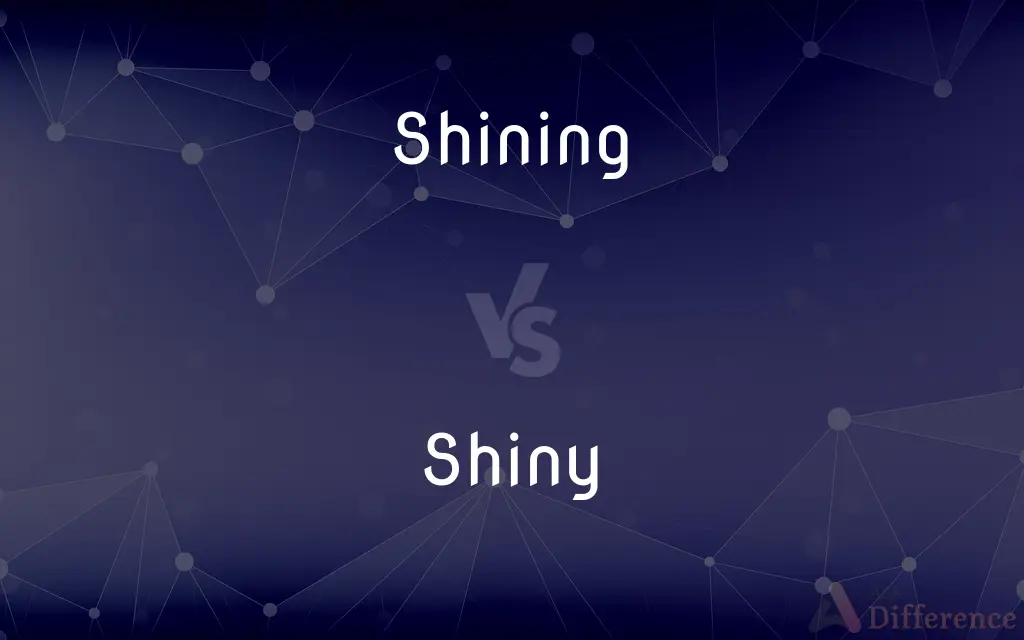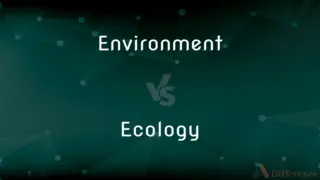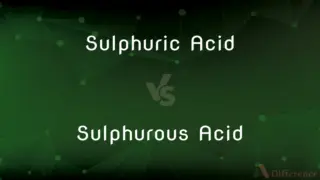Shining vs. Shiny — What's the Difference?
Edited by Tayyaba Rehman — By Urooj Arif — Updated on March 30, 2024
Shining refers to emitting or reflecting light, suggesting a bright or radiant quality, whereas shiny describes a surface that reflects light smoothly, often associated with polish and glossiness.

Difference Between Shining and Shiny
Table of Contents
ADVERTISEMENT
Key Differences
Shining is often used to describe an object or surface that is emitting light or has a luminous quality, indicating a source of light or brightness. On the other hand, shiny is typically used to refer to a surface that reflects light in a smooth and bright manner, emphasizing a polished or gleaming appearance.
Shining can imply a more natural or inherent brightness, as seen in celestial bodies like the sun or the moon, which are often described as shining due to their radiant energy. Whereas shiny suggests an external quality of an object, often a result of being polished or cleaned, making it highly reflective.
In literature, shining is frequently used metaphorically to describe someone or something as outstanding or excellent, showcasing a form of inner light or brilliance. Conversely, shiny is less commonly used in a metaphorical sense and is more often associated with physical characteristics, focusing on the appearance rather than an intrinsic quality.
Shining can also connote a steady or continuous emission of light, suggesting persistence or endurance in its brightness. In contrast, shiny might imply a momentary or surface-level quality, not necessarily indicative of an object's inherent characteristics but rather its current state.
While both terms are associated with light and brightness, shining leans more towards a state of being or an ongoing action, as in "the stars are shining," highlighting an active or dynamic condition. Shiny, however, describes a condition or characteristic, such as in "a shiny apple," focusing on a static quality.
ADVERTISEMENT
Comparison Chart
Definition
Emitting or reflecting light.
Having a smooth surface that reflects light.
Context
Natural brightness, luminosity.
Surface quality, glossiness.
Usage
Describes luminous bodies, metaphorical use.
Describes polished or clean surfaces.
Connotation
Inherent or natural light, brilliance.
External quality, polish, gleam.
Example
"The shining sun."
"A shiny car."
Compare with Definitions
Shining
Reflecting light brightly.
The lake was shining under the moonlight.
Shiny
Bright and clean.
The shiny windows gleamed in the sunlight.
Shining
Bright with moisture or wetness.
His eyes were shining with tears.
Shiny
Reflecting light smoothly.
The shiny surface of the table caught everyone's attention.
Shining
Outstanding in quality.
Her shining performance won her the award.
Shiny
Polished or glossy.
Her shiny hair reflected her meticulous grooming.
Shining
Glossy or polished.
His shoes were shining after a thorough polish.
Shiny
New or unworn.
He couldn't wait to wear his shiny new shoes.
Shining
Giving out or reflecting bright light
A shining expanse of water
Shiny
Having a sheen or luster.
He wore a suit with a shiny lapel to the gala.
Shining
Brilliant or excellent at something
He has set a shining example with his model behaviour
Shiny
Radiating light; bright.
Shining
To emit light.
Shiny
Bright from reflected light; glistening.
Shining
To reflect light; glint or glisten.
Shiny
Having a sheen from being rubbed or worn smooth.
Shining
To distinguish oneself in an activity or a field; excel.
Shiny
Reflecting light.
Shining
To be immediately apparent
Delight shone in her eyes.
Shiny
Emitting light.
Shining
To aim or cast the beam or glow of (a light).
Shiny
(colloquial) Excellent; remarkable.
Shining
Past tense and past participle shined To make glossy or bright by polishing.
Shiny
(obsolete) Bright; luminous; clear; unclouded.
Shining
Brightness from a source of light; radiance.
Shiny
(informal) Anything shiny; a trinket.
Shining
Brightness from reflected light; luster.
Shiny
(slang) Contraction of disparaging term "shiny arses", originating during World War Two, to describe a desk worker.[https://books.google.co.uk/books?id=mAdUqLrKw4YC&pg=PA1717]
Shining
A shoeshine.
Shiny
Bright; luminous; clear; unclouded.
Like distant thunder on a shiny day.
Shining
Excellence in quality or appearance; splendor.
Shiny
Reflecting light;
Glistening bodies of swimmers
The horse's glossy coat
Lustrous auburn hair
Saw the moon like a shiny dime on a deep blue velvet carpet
Shining white enamel
Shining
Fair weather
Rain or shine.
Shiny
Having a shiny surface or coating;
Glazed fabrics
Glazed doughnuts
Shining
Shines(Informal) Pranks or tricks.
Shiny
Made smooth and bright by or as if by rubbing; reflecting a sheen or glow;
Bright silver candlesticks
A burnished brass knocker
She brushed her hair until it fell in lustrous auburn waves
Rows of shining glasses
Shiny black patents
Shining
(Slang) Whiskey; moonshine.
Shiny
Abounding with sunlight;
A bright sunny day
One shining norming
When it is warm and shiny
Shining
Offensive Slang Used as a disparaging term for a black person.
Shining
Emitting light.
Shining
Reflecting light.
Shining
Having a high polish or sheen.
Shining
Having exceptional merit.
A shining example
Shining
Present participle of shine
Shining
A bright emission of light; a gleam.
Shining
Emitting light, esp. in a continuous manner; radiant; as, shining lamps; also, bright by the reflection of light; as, shining armor.
Shining
Splendid; illustrious; brilliant; distinguished; conspicious; as, a shining example of charity.
Shining
Having the surface smooth and polished; - said of leaves, the surfaces of shells, etc.
True paradise . . . inclosed with shining rock.
Some in a brilliant buckle bind her waist,Some round her neck a circling light display.
His sparkling blade about his head he blest.
Shining
Emission or reflection of light.
Shining
The work of making something shine by polishing it;
The shining of shoes provided a meager living
Shining
Marked by exceptional merit;
Had shining virtues and few faults
A shining example
Shining
Made smooth and bright by or as if by rubbing; reflecting a sheen or glow;
Bright silver candlesticks
A burnished brass knocker
She brushed her hair until it fell in lustrous auburn waves
Rows of shining glasses
Shiny black patents
Shining
Abounding with sunlight;
A bright sunny day
One shining norming
When it is warm and shiny
Shining
Reflecting light;
Glistening bodies of swimmers
The horse's glossy coat
Lustrous auburn hair
Saw the moon like a shiny dime on a deep blue velvet carpet
Shining white enamel
Common Curiosities
What makes something shining?
Something is shining if it emits or reflects light, giving it a bright appearance.
What makes an object shiny?
An object is shiny if it has a smooth surface that reflects light, making it appear glossy.
Can a surface be both shining and shiny?
Yes, a surface can be both shining and shiny if it emits light and has a glossy appearance.
Is shining used only in a literal sense?
No, shining can also be used metaphorically to describe something outstanding or excellent.
Is shining related to the source of light?
Yes, shining often relates to something being a source of light or reflecting it in a luminous way.
Does shiny imply a positive quality?
Shiny generally implies a positive quality, suggesting cleanliness, polish, or newness.
Are all shiny surfaces reflective?
Yes, the definition of shiny includes the ability to reflect light smoothly.
Can weather conditions be described as shining or shiny?
Weather conditions might be described as shining when sunlight is prominent, but they are not typically described as shiny.
Do shiny objects always shine?
Shiny objects may not always shine; they have the potential to reflect light smoothly, but actual shining depends on the lighting conditions.
How do maintenance practices affect shiny surfaces?
Regular cleaning and polishing are required to maintain a surface's shiny appearance.
What is the significance of shiny in fashion?
In fashion, shiny materials or finishes are used to attract attention and convey a sense of luxury or cleanliness.
How do emotions relate to shining or shiny?
Emotions can be described as shining when they are expressed vividly, while shiny is less commonly associated with emotions.
Does the concept of shining apply to all light sources?
Yes, shining can apply to natural and artificial light sources, as long as they emit or reflect light.
Can technology be described as shiny?
Yes, technology can be described as shiny, particularly when referring to gadgets with glossy finishes or newness.
Can shining describe a temporary state?
Shining can describe both a temporary and a permanent state, depending on the context.
Share Your Discovery

Previous Comparison
Environment vs. Ecology
Next Comparison
Kith vs. KinAuthor Spotlight
Written by
Urooj ArifUrooj is a skilled content writer at Ask Difference, known for her exceptional ability to simplify complex topics into engaging and informative content. With a passion for research and a flair for clear, concise writing, she consistently delivers articles that resonate with our diverse audience.
Edited by
Tayyaba RehmanTayyaba Rehman is a distinguished writer, currently serving as a primary contributor to askdifference.com. As a researcher in semantics and etymology, Tayyaba's passion for the complexity of languages and their distinctions has found a perfect home on the platform. Tayyaba delves into the intricacies of language, distinguishing between commonly confused words and phrases, thereby providing clarity for readers worldwide.















































